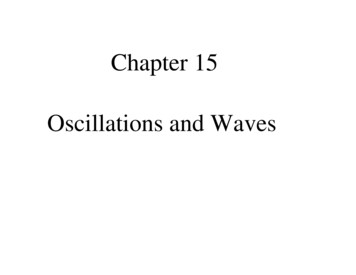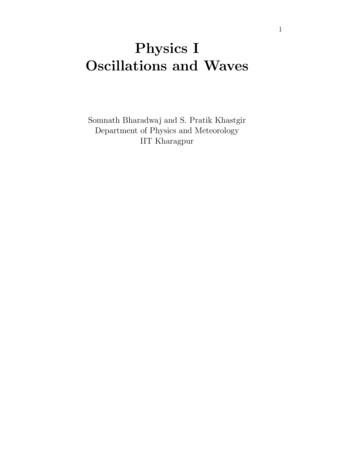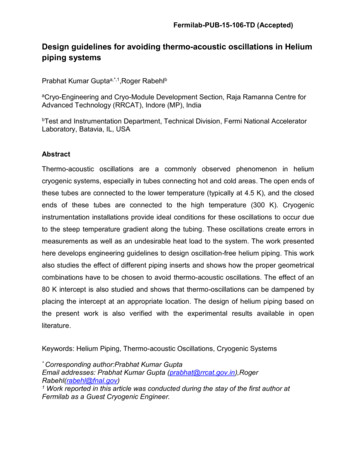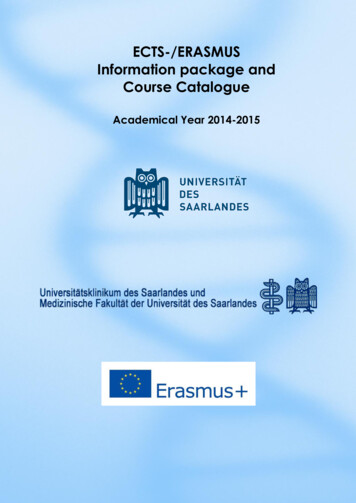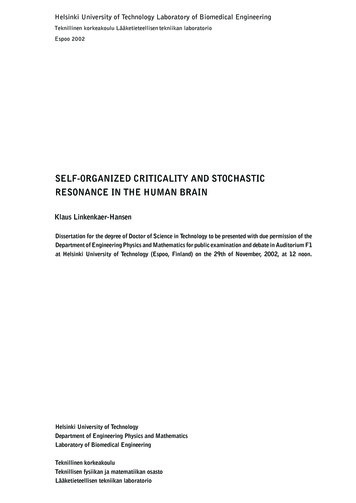
Transcription
Mon. Not. R. Astron. Soc. 000, 1–18 (2013)Printed 6 March 2013(MN LATEX style file v2.2)Ripple effects & oscillations in the broad FeKα line as aprobe of massive black hole mergersB.McKernan1,2,3 , K.E.S. Ford1,2,3, B.Kocsis4,6 & Z.Haiman51Department of Science, Borough of Manhattan Community College, City University of New York, New York, NY 10007, USAof Astrophysics, American Museum of Natural History, New York, NY 10024, USA3 Graduate Center, City University of New York, 365 5th Avenue, New York, NY 10016, USA4 Harvard-Smithsonian Center for Astrophysics, 60 Garden St., Cambridge, MA 02138, USA5 Department of Astronomy, Columbia University, New York, NY 10027, USA6 Einstein Fellow2 DepartmentAccepted. Received; in original formABSTRACTWhen a sufficiently massive satellite (or secondary) black hole is embedded in a gasdisk around a (primary) supermassive black hole, it can open an empty gap in the disk.A gap-opening secondary close to the primary will leave an imprint in the broad component of the Fe Kα emission line, which varies in a unique and predictable manner. Ifthe gap persists into the innermost disk, the effect consists of a pair of dips in the broadline which ripple blue-ward and red-ward from the line centroid energy respectively,as the gap moves closer to the primary. This ripple effect could be unambiguouslydetectable and allow an electromagnetic monitoring of massive black hole mergers asthey occur. As the mass ratio of the secondary to primary black hole increases toq & 0.01, we expect the gap to widen, possibly clearing a central cavity in the innerdisk, which shows up in the broad Fe Kα line component. If the secondary stalls at 102 rg in its in-migration, due to low co-rotating gas mass, a detectable ripple effectoccurs in the broad line component on the disk viscous timescale as the inner diskdrains and the outer disk is dammed. If the secondary maintains an accretion diskwithin a central cavity, due to dam bursting or leakage, a periodic ’see-saw’ oscillationeffect is exhibited in the observed line profile. Here we demonstrate the range of rippleeffect signatures potentially detectable with Astro-H and IXO/Athena, and oscillationeffects potentially detectable with XMM-Newton or LOFT for a wide variety of mergerand disk conditions, including gap width (or cavity size), disk inclination angle andemissivity profile, damming of the accretion flow by the secondary, and a mini-diskaround the satellite black hole. A systematic study of ripple effects would require atelescope effective area substantially larger than that planned for IXO/Athena. Futuremission planning should take this into account. Observations of the ripple effect andperiodic oscillations can be used to provide an early warning of gravitational radiation emission from the AGN. Once gravitational waves consistent with massive blackhole mergers are detected, an archival search for the FeKα ripple effect or periodicoscillations will help in localizing their origin.Key words: galaxies: active – (stars:) binaries:close – planets-disc interactions –protoplanetary discs – emission: accretion1INTRODUCTION6Galactic nuclei host supermassive black holes ( 10 M )(Kormendy & Richstone 1995) and should be the sites ofmergers of massive black holes. Major and minor galactic E-mail:bmckernan at amnh.org (BMcK)c 2013 RASmergers in ΛCDM cosmology should inject supermassiveand intermediate mass black holes (BH) into the dominantgalaxy. Following the merger of two BH-harboring galaxies,the BHs sink to the bottom of the new galactic potentialvia dynamical friction in approximately a galactic dynamical timescale (Begelman, Blandford & Rees 1980). In addition to stellar interactions (e.g. Preto et al. 2011), many
2B. McKernan, K.E.S. Ford, B. Kocsis & Z.Haimanstudies have shown that gas in the vicinity of the binarycould aid in hardening the binary down to pc separations(e.g. Escala et al. 2005; Dotti et al. 2007; Mayer et al. 2007;Haiman et al. 2009; Lodato et al. 2009; Cuadra et al. 2009;Nixon et al. 2011; Chapon, Mayer & Teyssier 2011). Blackholes of intermediate mass can also grow quickly in gas disksin active galactic nuclei (AGN) via stellar/stellar remnantcollisions and gas accretion (Levin 2007; McKernan et al.2012) and orbital decay can generate a later merger withthe central black hole. Massive black hole mergers shouldcorrespond to some of the strongest sources of gravitationalwaves in the Universe. Since we have yet to detect gravitational radiation directly, any electromagnetic signature thatallows us to track massive mergers as they occur will bevaluable for the study of strong gravity and the growth ofthe largest black holes in the Universe.Gravitational torques from satellites in gas disks actto repel gas away from the satellite orbit. Sufficiently massive satellites can open empty annular gaps in protoplanetary disks (e.g. Lin & Papaloizou 1986; Pollack et al. 1996;Ward 1997; Armitage 2010; Duffell & MacFadyen 2012, &references therein). Analogously, sufficiently massive blackholes can open gaps in AGN gas disks (e.g. Syer & Clarke1995; Ivanov et al. 1999; Levin 2007; Dotti et al. 2007;Haiman et al. 2009; McKernan et al. 2012; Baruteau et al.2012), leaving a number of unique observational signatures (McKernan et al. 2013). As the ratio of satelliteblack hole mass to central black hole increases to 10 2 6q 6 1, the gap can widen to form a central cavity (e.g. Artymowicz & Lubow 1994; Liu, Wu & Cao 2003;Milosavljevic & Phinney 2005; MacFadyen & Milosavljevic2008; D’Orazio, Haiman & MacFadyen 2012, & referencestherein). A gap-opening black hole in the innermost AGNdisk, analogous to a gap-opening ’hot Jupiter’ in a protoplanetary disk, can leave an imprint on a relativisticallyand gravitationally broadened FeKα line profile. The ripple effects and oscillations that result from a variety ofblack hole merger scenarios: (1) are potentially detectablewith near-future X-ray detectors such as Astro-H,LOFT andIXO/Athena and possibly with present instruments such asXMM-Newton , (2) can be used to follow massive mergers as they happen, (3) provide advance warning of gravitational radiation from the source (Kocsis et al. 2008) and(4) can test models of extreme gravity, independent of thedetection of gravitational radiation. However, detecting theeffects outlined here with present and future proposed missions requires serendipity. To systematically survey sites ofpotentially merging massive binaries covering all the effectsdiscussed here requires at a minimum, the planned effectivearea of LOFT combined with the planned spectral resolution of IXO/Athena.In section §2 we review the broad FeKα line and outline the ripple effect caused by a narrow annular gap aroundthe secondary’s orbit, deep in the potential well of a supermassive black hole. We also discuss several other differentplausible configurations for the gas distribution around binaries. In section §3 we demonstrate the effects of an annular gap on the broad FeKα line profile for a range of basicobservables (angle to observer, X-ray emissivity profile). Insection §4 we discuss other possible circumbinary gas diskconfigurations for merging BHs including stalled migration,damming of the accretion flow, a central cavity and a sec-ondary accretion disk around the gap-opening black hole. Insection §5 we discuss the gravitational wave signals that maycorrespond to the FeKα broad line profiles. Finally in §6 wesummarize our main results and present our conclusions.2A RIPPLE EFFECT IN THE BROAD FEKαLINE2.1The broad FeKα line componentBroad FeKα lines are observed in several nearby AGN (e.g.Nandra et al. 1997; Turner et al. 2002; Reynolds & Nowak2003; Braito et al. 2007; Miniutti et al. 2007). The narrow core of the FeKα line observed in AGN (e.g.Yaqoob & Padmanabhan 2004) does not correlate significantly with outflowing gas (McKernan et al. 2007) and sopresumably originates in fluorescing cold gas 1 far from thesupermassive black hole (Shu, Yaqoob & Wang 2010). Weshall not discuss the narrow component further here. However, the broad FeKα line component in (AGN) is widelybelieved to originate in fluorescent Fe deep in the gravitational potential well of the central supermassive black hole.The broad FeKα line profile is complicated by ’horns’ dueto relativistic boosting and a strong red wing due to gravitational broadening (see e.g. Reynolds & Nowak 2003, for areview).There is some recent controversy over the originof the broad component of the line, with some suggestions that it originates in complex absorption (e.g.Miller, Turner & Reeves 2009). However, partial coveringmodels do not eliminate the need for a broad FeKα component (Gallo et al. 2011) and Compton-thick outflows areruled out in the innermost regions of the accretion disk(Reynolds 2012). Furthermore, the appearance of the broadline during transit events in AGN (McKernan & Yaqoob1998) is consistent with an origin in the innermost accretiondisk (Weaver & Yaqoob 1998). So it seems we should expect a broadened Fe Kα line component originating deep inthe gravitational potential well around supermassive blackholes.Although the structure of the innermost accretion flowis unknown, it is common to assume a disk structure.The innermost parts of a disk must lie in the orbitalplane of a massive merging binary (Ivanov et al. 1999).In this context, the broad Fe Kα line profile has beenused to test models of warped disks (Hartnoll & Blackman2000; Fragile, Miller & Vandernoot 2005), thick disks(Wu & Wang 2007), accretion rings (Sochora et al. 2011),spiral density waves (Hartnoll & Blackman 2002) and thepresence of a binary with two disks (Sesana et al. 2012).Given the origin of the broad component of the Fe Kα linein the innermost regions of the AGN disk, a gap or cavity inthe inner disk due to the presence of a massive (secondary)black hole will have an effect on the broad line profile. Wediscuss this effect in detail in the remainder of this paper.Following Fabian et al. (1989), we calculate theflux emitted by a axisymmetric thin disk orbiting aSchwarzschild black hole. The ratio of the emitted energies1By ’cold’ we mean Fe i-Fe xviic 2013 RAS, MNRAS 000, 1–18
Ripple effect in broad FeKα linesfrom a point in the disk to the observed energy is given by(Fabian et al. 1989) 1/2 6Mcosβ(1 z) 1 (1)1 r[r(1 tan2 ξ)/M 1]1/2where (r, φ) is the location of the emitting point in the disk(with r in units of rg GM/c2 , the gravitational radius). Ineqn. (1) M is the black hole mass, β is the angle between thedisk plane and the plane of the photon trajectory, ξ π/2is the angle between the emission of the photon and theline connecting the emitting point to the black hole. Thequantity cosβ may be written as (Fabian et al. 1989)cosβ cosφsinθ[cos2 θ cos2 φsin2 θ]1/2(2)with θ the angle between the observer and the disk. Thespecific intensity in the frame of the emitting plasma is approximated as a delta function Iem ǫδ(E E0 ) where E0is the line rest energy. The structure of both the hot corona(source of the X-ray continuum) and the inner disk (sourceof the fluorescing Fe) is unknown, so ǫ the disk emissivityis simply assumed to be (r/M ) k . Therefore the specificflux measured by the observer from portion rdrdφ of thedisk is then given by (Fabian et al. 1989)dFobs 1 ΩIemrdrdφ(1 z)3 (r, φ)(3)where the solid angle dΩ D 2 bdbdφ′ where D is the distance to the disk from the observer, b is the photon impactparameter and φ′cosθ. φcos2 φ sin2 φcos2 θ(4)In the weak field limit, the photon geodesics can be approximated with straight lines, which means that not allrelativistic effects are fully calculated at 20rg in this approach (Beckwith & Done 2004). By integrating eqn. (3) asZ 2π Z r1Z 2π Z routerFobs dFobs(5)dFobs 0rinner0r2where the disk extends from rinner to router , with a gap excavated from radii r1 to r2 , we obtain the observed broad lineflux from a disk containing a gap. In the limit as r1 r2 ,and if the disk extends to the innermost stable circular orbits (ISCO), rinner rISCO , we recover the observed broadline flux from the total disk. In the limit as rinner r1 werecover the observed broad line flux due to the inner diskminus a cavity spanning rISCO to r2 .2.2Gap-opening in disks and merging black holesThe disk emissivity which produces the broad Fe Kα linecomponent depends on both the structure of the X-ray continuum emitting corona plus the gas surface density distribution in the circumbinary disk. The geometry of both thecorona and inner disk are poorly understood, particularlyat the late stages of a merger with the central supermassiveblack hole. The main purpose of this paper is to illustratethat different possible gas configurations produce very different broad FeKα line profiles. Although our illustrationsare based on toy models, the main features should be robust,and potentially distinguishable in observations with Astro-Hc 2013 RAS, MNRAS 000, 1–183and IXO/Athena. In this section, we outline possible models for the circumbinary gas, including those with a narrowannular gap, a fully empty central cavity, or a central cavitywith possible minidisks inside the cavity. Throughout thisdiscussion, we emphasize the very large existing theoreticaluncertainties.BH binaries are commonly believed to be surrounded by a thin (H/R . 1) circumbinary disk.In models where the binary results from a galaxygalaxy merger, the merger is expected to deliver thenuclear BHs (e.g. Springel, Di Matteo & Hernquist 2005;Robertson et al. 2006), along with copious amounts of gas(Barnes & Hernquist 1992), to the central regions of the newgalaxy. The gas cools efficiently, and loses angular momentum, creating a thin sub-parsec disk in which the pair of BHsare embedded (e.g. Dotti et al. 2009; Hopkins & Quataert2010; Chapon, Mayer & Teyssier 2011). IMBHs with lowermasses can also grow quickly in situ in the disk around asingle supermassive black hole, again producing a pair (ormore) of BHs embedded in a thin disk (McKernan et al.2012).A BH binary can exchange angular momentum withthe disk, distorting the disk’s density profile, causing thesecondary BH to migrate inward. In the limit of a very lowmass secondary (q M2 /M1 1), the distortions, in theform of spiral density waves, remain in the linear regime(and the corresponding Type I migration is very rapid; e.g.Goldreich & Tremaine 1980). In this limit, the FeKα linewould be hardly affected by the presence of the low-masssecondary 2 . As the mass of the secondary increases, gas isgravitationally torqued away from the orbit, lowering theco-rotating gas density and a particularly rapid form of migration (Type III) may occur (Masset & Papaloizou 2003;McKernan et al. 2011b). Once the secondary becomes sufficiently massive it will open an empty annular gap in the disk,analogous to gaps known to exist in protoplanetary disks.This happens above the critical mass ratio (e.g. Armitage2010) of 1/2 5/227πHq α1/2(6)8rwhere H/r is the geometric thickness (aspect ratio)of the disk and α is the disk viscosity parameter(Shakura & Sunyaev 1973). A black hole with q 10 4should be able to open a gap in a fiducial AGN disk. Thismass range spans massive stars or black holes of 102 M inaccretion disks around 106 M supermassive black holes(McKernan et al. 2012), all the way up to supermassiveblack hole binaries that form long after a major galacticmerger has occurred. The radial extent of the gap would beof order a few Hill radii ( RH ). In this case, the secondarycan be regarded as a particle in the disk, migrating inwardon the viscous time-scale (so-called Type II migration).When the secondary arrives at the radius where thelocal disk mass is too small to absorb the secondary’s angular momentum, its migration must stall (or at least slow2However, if the local gas mass is low enough, or for low enoughvalues of H/r, α in the innermost disk, even low-mass migratorsexpected in the AGN disk (McKernan et al. 2011a, 2012) couldopen a gap or cavity and affect the Fe Kα line as described here.
4B. McKernan, K.E.S. Ford, B. Kocsis & Z.Haimandown). An important point is that “standard” thin diskshave relatively low mass, and this stalling occurs at fairlylarge binary separations. With the exception of very unequalmasses q . 0.01, the transition takes place well in the outerregion of the disk, at r several 103 rg . Even for q 1binaries, the transition is located atrstall 260(M1 /107 M ) 2/7 (q/10 4 )2/7(7)Schwarzschild radii, which may lie outside the region of interest for producing broad FeKα lines depending on router(the above equation assumes standard disk parameters;see eqn. 25 in Haiman et al. 2009 for the full expression).Once inside this stalling radius, the secondary is no longerable to maintain steady Type II migration on the viscous time-scale, and the evolution of the binary disk system from this point onward becomes very poorly known.The inner disk - whose viscous time is short - is believed to drain onto the primary, creating a central cavity. Continued accretion from larger radii causes a pileup of gas just outside the secondary’s orbit, analogous toa dam in a river (Syer & Clarke 1995; Ivanov et al. 1999;Milosavljevic & Phinney 2005; Chang et al. 2010; Rafikov2012). If the dam is 100% efficient in continuing to blockthe gas arriving from large radii, then the binary, at smallseparations, will be surrounded by an empty inner cavity, devoid of any gas. Such inner cavities have been seen in manynumerical simulations (starting with the seminal work byArtymowicz & Lubow (1994)). However, simulations do notfollow the system on long enough timescales to determinewhether such a cavity could persist for many viscous times.In the face of ongoing accretion, an initial cavity may begradually refilled (if the “dam” is porous), or else the gasaccumulated outside the orbit may eventually cause the damto “burst” (Kocsis, Haiman & Loeb 2012a,b).An empty cavity would of course strongly modify theshape of the FeKα line. However, this picture is oversimplified. Many numerical simulations imply that gascan enter such a cavity in narrow collimated streams(Artymowicz & Lubow 1996; Hayasaki, Mineshige & Sudou2007; MacFadyen & Milosavljevic 2008; Cuadra et al. 2009;Roedig et al. 2011, 2012; Shi et al. 2011). Such streams mayfeed a “minidisk” around the secondary and perhaps alsothe primary BH (Hayasaki et al. 2008; Sesana et al. 2012;Farris et al. 2012). A minidisk around the secondary may befavored, but the details depend on the angular momentumand shocks in the material in the streams. The streamers andminidisks could create some additional FeKα emission. Forexample, if both disks emit, there would be a double FeKαline (Sesana et al. (2012)). On the other hand, it is unclearwhether such streams and minidisks may persist down tosmall binary separations. At separations of . 200rg q 2 (seeeqn. 30 in Haiman et al. 2009 for the full expression, including dependencies on disk parameters), the binary BH emitsGWs efficiently and is driven to merger by this GW emission. It effectively decouples from the disk (Liu, Wu & Cao(2003); Milosavljevic & Phinney (2005)) and “runs away”.The merger timescale is given by (Peters 1964) 3 6 2 410 M 10 M aτGW 1012 yr(1 e2 )7/2 (8)M2M10.001pcwhere M2 is the mass of the secondary, M1 is the mass ofthe primary, a is the binary separation and e is the sec-ondary orbital eccentricity. For a secondary on a circularized orbit with q 3 10 3 located at a (10)100rg inan AGN disk, τGW (30yr)0.3Myr around a 108 M SMBHand τGW (1yr)0.01Myr around a 106 M SMBH respectively. Simulations in the relativistic regime found that gasstreams can follow the binary to small radii ( few Rs ; e.g.Noble et al. 2012; Farris et al. 2011, 2012), but these simulations start with small binary separations, with gas assumedto have followed the BH to these initial separations.As emphasized recently by Kocsis, Haiman & Loeb(2012a,b), even apart from possible streamers and minidisks inside the central cavity, the formation of the cavity itself, at large radii, is still uncertain. The coupledtime-dependent processes of the secondary’s migration, inner cavity formation, and damming-up of gas outside thesecondary’s orbit, has not been modeled self-consistently,even in one-dimensional calculations. However, using selfconsistent steady-state solutions, Kocsis, Haiman & Loeb(2012b) have argued that in many cases, pile-up can causea dam overflow at large binary separations. In this case,when the binary arrives at small radii relevant to the FeKαline, the gas configuration would presumably resemble afilled disk, with an annular gap (of order the Hill radius).Although the above is yet to be demonstrated by a selfconsistent calculation, it is at least suggested by recent simulations of Baruteau et al. (2012). This is the only existingsimulation that looks at small binary separations, in theGW-driven regime, and does not manually insert an emptycavity in the beginning. They show that the secondary movesinward, “ice-skating” across the inner disk (with the innerdisk material continually crossing the secondary’s orbit outward, on horse-shoe orbits). This simulation is in 2D, andassumes a constant kinematic viscosity physics, which maynot be accurate. Nevertheless, it suggests that if the cavityfilled in at large radius, it will remain filled until the end,except for a narrow annular gap around the secondary.We are motivated by the above discussion to considerthe impact on the Fe Kα line of four different circumbinarygas disk geometries, all variations on a standard single-BHaccretion disk: (i) a narrow annular gap around the secondary, (ii) an empty central cavity, (iii) a central cavitysurrounded by an overdense ring (’dam’), and (iv) a centralcavity with a small, circumsecondary accretion disk (’minidisk’) inside it. We regard (i) as our fiducial case, addressingit first in §2.3 and §3. We then examine the alternative scenarios (ii)-(iv) in §4.2.3A ripple effect in the broad FeKα linecomponentAs a gap-opening black hole migrates inward in an AGNdisk, the empty gap spans parts of the disk that produceever bluer and redder parts of the broad Fe Kα line. Therefore we expect flux ’notches’ to be removed from the broadline profile. As the annulus moves inward on the disk viscous timescale, we expect the notches to ripple red-wardand blue-ward respectively from the line centroid. Fig. 1(from McKernan et al. (2013)) demonstrates this ripple effect for a gap-opening black hole located at circularizedorbit radius R centered in an empty gap of width 2RHwhere RH (q/3)1/3 R. The black hole migrates inwardwith the gap from 100rg to 6rg . We assumed q 3 10 3c 2013 RAS, MNRAS 000, 1–18
00.2Flux0.4Ripple effect in broad FeKα lines45678EnergyFigure 1. From McKernan et al. (2013), showing Iron line fluxin arbitrary units versus Energy in units of keV,binned at approximately the energy resolution ( 7eV) expected for Astro-H.The curves demonstrate the progression of the ’ripple effect’ inthe Fe Kα line profile given the in-migration of a gap-openingblack hole (mass ratio q 3 10 3 ) located at R in the innerdisk. The empty gap has width 2RH where RH (q/3)1/3 R. Thedisk has an assumed X-ray emissivity radial profile of r 2.5 andthe angle to the observer’s sightline is θ 60o (where θ 0o isface-on). The solid black curve indicates the unperturbed Fe Kαline profile (i.e. no gap). The turquoise solid curve corresponds tothe same Fe Kα line but with an annulus at 90 9rg in the innerdisk. Dark blue solid curve denotes an annulus at 50 5rg , Greensolid curve corresponds to an annulus at 20 2rg and the dashedred curve corresponds to an annulus at 10 1rg .for ease of calculation, the disk is oriented at 60o to theobserver’s line of sight, the X-ray emissivity profile goesas r 2.5 and the broad line flux is assumed to come from 100rg in the disk (i.e. rinner 6rg , router 100rg ). If wechange router to larger radii (e.g. Niedźwiecki & Zycki 2008;Niedźwiecki & Miyakawa 2010), the broad line profiles depicted throughout this paper would appear more centrallypeaked with ’horns’ closer together, resulting in a slight decrease in the prominence of the notches and oscillationsdescribed here. If router is larger, we become sensitive tostalling radii, gaps and cavities further out in the accretion disk. Exactly how sensitive to detection of the effectsdiscussed here depends on the line emissivity ( r k ) profile. If the emissivity profile is steep (k 3) then most lineflux originates close to the BH and we have low sensitivityto features in the disk much further than 100rg . If theemissivity profile is shallower (k 2), for large router , theline ’horns’ correspond to material around 100 150rg ,so gaps at these radii could be detected. In general, oursimple assumption that the broad line flux comes from. 102 rg ), is reasonably consistent with fits to many observedbroad line components (Reynolds & Nowak 2003). Likewise,in the following discussion we do not correctly treat generalrelativistic effects such as light-bending, blurring and BHc 2013 RAS, MNRAS 000, 1–185spin (e.g. Dovčiak et al. 2004; Brenneman & Reynolds 2009;Dauser et al. 2010 2010). These effects, if properly treated,will tend to smear out sharper notches in the red wing ofthe broad FeKα line and modify line flux originating from. 20rg . Even though we ignore the many possible confounding effects (e.g. continuum absorption, the location and variation of the continuum source, broken axi-symmetry), weexpect that the kinds of spectral features here are broadlyrobust and allow us to take a first step in characterizing different scenarios of merging massive black holes in the inneraccretion disk.From Fig. 1, the progression of the ripple effect is quiteclear. As the satellite black hole and gap migrate into theinner 100rg of the disk, a flux deficit appears (turquoisesolid curve) compared to the unperturbed profile (black solidcurve). As migration continues, matching notches are removed from the broad red wing and the blue wing of theprofile, with the deepest notches in the blue wing. The twinnotches move apart, one red-ward, the other blue-ward further from the line centroid (6.40keV) in a distinctive monotonic progression. As the gap moves inward in the disk from50rg (dark blue curve) to 20rg (green curve) to 10rg (redcurve), the blue notch moves from 7.1keV to 7.6keV in theblue wing, and the red notch moves from 5.6keV to 4.2keVin the broad red wing. For a 3000M gap-opening IMBHaround a 106 M supermassive black hole, the progressionfrom green to red curve in Fig. 1 via GW emission takes(eqn. 8) 16yrs and from red curve to final merger takes 1yr. Because of the shorter timescales, low mass AGNexhibiting broad Fe Kα line profiles (e.g. MCG-6-30-15) arethe prime targets for observations searching for this rippleeffect, and the massive mergers that cause it.AGN that display this ripple effect in the broad Fe Kαline will be some of the most luminous sources of gravitational radiation in the Universe. By searching for the latterstages of a progression as in Fig. 1, we can follow the final stages of massive mergers electromagnetically. The finalstages of a ripple effect in the broad FeKα line will provideadvance warning of an outburst of gravitational waves fromthis AGN. Conversely, once gravitational waves consistentwith an IMBH-supermassive black hole merger are actuallydetected, an archival search for the FeKα ripple effect canbe used to localize the source.We expect departures from the predicted progression inFig. 1 at very small radii either as the disk profile changesor as the gravitational radiation luminosity increases dramatically and perturbs the disk (α and H/r may changeconsiderably). So the behaviour of the broad component ofthe Fe Kα line may be complicated in the final stages ofthe merger (in the limit of small disk radii). Variations fromthe predicted profile at small radii will include the effectsof gravitational radiation on the accretion disk. So tracking the ripple effect may allow us to directly test modelsof massive mergers and gravitational radiation, without actually detecting gravitational radiation. The Fe Kα bandcan also be spectrally complicated by emission lines. Bymonitoring the monotonic change in energy of the blue andred dips, we can break the degeneracy associated with highenergy Fe emission lines superimposed on the FeKα complex (e.g. McKernan & Yaqoob 2004). Curious ’notch’-likefeatures have been observed in broad Fe Kα line components (e.g. Yaqoob & Serlemitsos 2005), but the collecting
6B. McKernan, K.E.S. Ford, B. Kocsis & Z.Haimanarea and the energy resolution of the high energy transmission gratings on board Chandra are insufficient to resolve these features and follow them over time. The broadcomponent of the Fe Kα line can vary quite significantlyover time (e.g. Iwasawa et al. 1996; deMarco et al. 2009;Svoboda et al. 2012), but it has been difficult to determinethe nature of the variability given detector limitations.The energy resolution of the micro calorimeter plannedfor the Astro-H mission will be 7eV in the FeKα band(Takahashi et al. 2010). This exceptional resolution combined with moderate collecting area should be sufficient todistinguish between absorption features and narrow, monotonically migrating notches of the kind depicted in Fig. 1in long, repeated observations of nearby, X-ray bright AGN(e.g. Nandra et al. 1997). However, it is important to notethat Fig. 1 displays only the predicted broad line flux. Tosystematically obtain broad line spectra that can distinguishbetween the different cases in Fig. 1 requires a minimumtelescope effective area of that planned for LOFT ( 10m2at 6.4keV), together with the planned spectral resolutionof ( 5 7eV at 6.4keV) for Astro-H and IXO/A
disk, which shows up in the broad Fe Kα line component. If the secondary stalls at 102r g in its in-migration, due to low co-rotating gas mass, a detectable ripple effect occurs in the broad line component on the disk viscous timescale as the inner disk drains and the outer disk is dammed. If the secondary maintains an accretion disk

